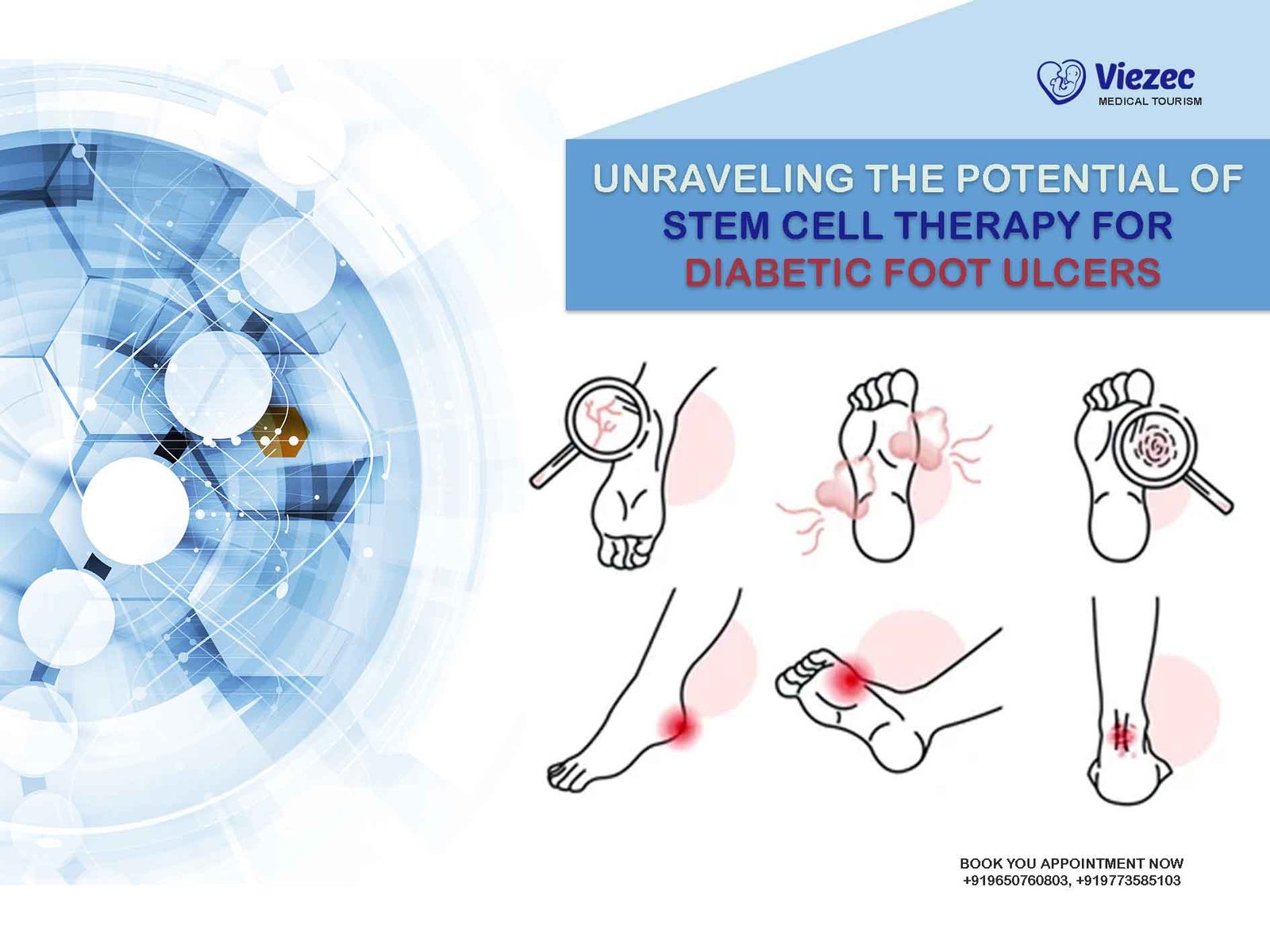In the complex landscape of diabetes, the emergence of diabetic foot ulcers poses a significant challenge, often leading to prolonged suffering and complications. Amidst this medical intricacy, the spotlight turns to a revolutionary avenue of hope: Stem Cell-Based Therapies. This article navigates through the promising realm where cutting-edge science meets the urgent needs of diabetic foot ulcer patients. As we explore the potential of regenerative medicine, the focus is on how stem cells, with their transformative capabilities, illuminate a path toward healing and relief. Join us on a journey into the scientific breakthroughs and compassionate possibilities that make stem cell-based therapies a beacon of optimism for those grappling with diabetic foot ulcers.
Understanding Diabetic Foot Ulcers
Diabetic foot ulcers, intricate wounds resulting from diabetes-related complications, demand a nuanced comprehension. Caused by a combination of neuropathy, poor circulation, and immune system impairments, these ulcers pose severe risks if left unattended. The intricate interplay of factors contributing to their development underscores the urgency of effective treatment. Beyond being mere wounds, diabetic foot ulcers signify a complex challenge in diabetes management. This section unravels the causes and complications, shedding light on the gravity of the condition and emphasizing the critical need for innovative solutions that go beyond conventional approaches to ensure comprehensive care for affected individuals.
Promise of Stem Cell-Based Therapies
Stem cell-based therapies represent a revolutionary frontier in healthcare, holding unparalleled promise for conditions like diabetic foot ulcers. These therapies harness the remarkable regenerative potential of stem cells, offering a beacon of hope for patients. By leveraging the body’s natural healing mechanisms, stem cell therapies aim to address the root causes of ailments, fostering tissue regeneration and mitigating inflammation. The potential benefits extend beyond conventional treatments, showcasing a paradigm shift in healthcare. As research advances, the promise of these therapies grows, ushering in a new era of personalized and effective solutions for individuals grappling with challenging medical conditions.
Types of Stem Cells Used in Therapy
Various types of stem cells are harnessed for their unique regenerative properties. Embryonic stem cells, derived from embryos, exhibit remarkable versatility. Adult stem cells, found in mature tissues, contribute to tissue repair and regeneration. Induced pluripotent stem cells, generated from adult cells, offer flexibility without ethical concerns. Understanding these distinct types is crucial for unlocking the full potential of stem cell therapies in addressing conditions like diabetic foot ulcers.
Research and Clinical Trials
Research and clinical trials in the realm of stem cell-based therapies for diabetic foot ulcers are pivotal in shaping the future of treatment. Ongoing studies delve into the intricate mechanisms of action, evaluating the effectiveness and safety of these innovative approaches. Recent advancements and successful trials underscore the potential of stem cells to revolutionize wound healing. The scientific community’s dedication to rigorous research ensures a thorough understanding of the benefits and challenges associated with implementing these therapies in clinical settings.
How Stem Cells Aid in Wound Healing
Stem cells, acting as nature’s repair kit, play a pivotal role in wound healing. Their unique ability to transform into specialized cells and promote tissue regeneration accelerates the recovery process. Stem cells not only replace damaged cells but also exhibit anti-inflammatory properties, reducing swelling and fostering a conducive environment for healing. This regenerative prowess makes stem cell therapy a promising avenue for addressing complex wounds, such as diabetic foot ulcers, offering hope for enhanced and expedited recovery.
Challenges and Considerations
Navigating the promising landscape of stem cell-based therapies isn’t without hurdles. Ethical quandaries surrounding the use of embryonic stem cells and the need for stringent safety regulations pose substantial challenges. Balancing innovation with safety considerations is paramount, and this section explores the delicate intricacies of these challenges. As the medical community embraces the potential of stem cell therapies, addressing these ethical and safety concerns becomes pivotal in realizing the transformative benefits for diabetic foot ulcer patients.
Comparative Analysis with Conventional Treatments
A comparative analysis between stem cell therapies and conventional treatments is essential. While traditional approaches focus on symptom alleviation, stem cell therapies aim for comprehensive healing. Evaluating their effectiveness and long-term outcomes becomes pivotal in guiding patients and healthcare providers toward informed decisions. This section delves into the nuanced differences, shedding light on the potential paradigm shift these innovative therapies bring to the conventional landscape of diabetic foot ulcer care.
Patient Experiences and Success Stories
Patient experiences and success stories narrate tales of triumph over adversity. These firsthand accounts vividly illustrate the transformative impact of stem cell-based therapies. From accelerated wound healing to restored mobility, these stories serve as beacons of hope for individuals navigating the challenges of diabetic foot ulcers. Exploring these narratives not only inspires but also sheds light on the tangible benefits that stem cell treatments bring to those seeking relief from this debilitating condition.
Expert Opinions and Medical Community Views
Expert opinions provide a comprehensive understanding of the role these innovative treatments play in the realm of diabetic care. By exploring the viewpoints of medical professionals, readers gain valuable insights into the credibility and potential advancements in stem cell therapies, shaping a well-informed perspective on their application in the field of healthcare.
Addressing Common Concerns and Myths
In the realm of stem cell-based therapies, misconceptions and concerns often cloud the understanding of their efficacy and safety. This section dispels prevalent myths, providing clarity on topics like the ethical use of stem cells, potential side effects, and the true scope of these innovative treatments. By addressing common concerns, readers can make more informed decisions about the role of stem cell therapies in addressing diabetic foot ulcers.
Recommendations for Patients and Caregivers
Navigating stem cell therapies for diabetic foot ulcers requires informed decisions. Patients and caregivers should consult healthcare professionals for personalized guidance. Prioritize understanding the potential benefits and risks of these therapies, considering individual health conditions. Integrating stem cell treatments into a comprehensive plan, complementing existing care, can enhance outcomes. Stay informed about advancements, and actively engage in open communication with the medical team to ensure the best possible support and results. The potential for transformative change in the management of this condition offers optimism for a brighter future.
FAQs
- Are stem cell therapies a cure for diabetic foot ulcers?
- Stem cell therapies show promising results in promoting healing, but the term “cure” requires further research and long-term data.
- What are the ethical concerns surrounding stem cell-based treatments?
- Ethical concerns often revolve around the use of embryonic stem cells, prompting ongoing discussions within the scientific and ethical communities.
- How accessible are stem cell therapies for the general population?
- Currently, accessibility is limited, but ongoing efforts aim to make stem cell therapies more widely available in the future.
- Do stem cell therapies have any side effects?
- While generally considered safe, potential side effects exist, emphasizing the importance of thorough research and consultation with healthcare professionals.
- What role do healthcare professionals play in recommending stem cell therapies?
- Healthcare professionals play a crucial role in assessing individual cases and providing recommendations based on the patient’s specific needs and conditions.
Read related articles here:-
| Harnessing Mesenchymal Stem Cells for Treating Diabetic Foot Complications |
| Stem Cell Therapy for Diabetic Foot Ulcers: A Promising Approach |
| Stem Cell Research for Diabetic Foot Ulcer Management |









